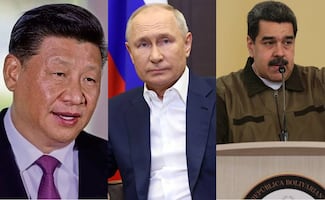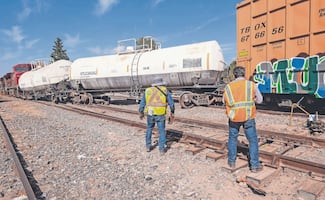Más Información

Videos: Reportan múltiples explosiones en Caracas, Venezuela; algunas zonas se quedaron sin electricidad

Rusia exige una aclaración "inmediata" sobre el paradero de Nicolás Maduro; China pide a sus ciudadanos no viajar a Venezuela

Trump ofreció a Maduro "múltiples salidas": JD Vance; el líder chavista era un prófugo de la justicia, dice el vicepresidente de EU

Maduro responderá por cargos de narcotráfico y terrorismo en EU: Pam Bondi; "enfrentarán todo el rigor de la justicia estadounidense"
General Luis Cresencio Sandoval
, the head of the Defense Ministry , announced that at least six criminal organizations operate in the Valley of Mexico metropolitan area , which includes Mexico City , the State of Mexico , and Hidalgo .

General Sandoval revealed the Jalisco Nueva Generación Cartel , Guerreros Unidos , Los Caballeros Templarios , and La Familia operate in central Mexico. He mentioned other two organizations based in Mexico City but explained they are not drug cartels, but splinter groups .

Furthermore, the federal government discovered an alliance between La Familia and Los Caballeros Templarios to prevent Guerreros Unidos from taking over the State of Mexico.

In the metropolitan area, the Jalisco Nueva Generación Cartel is led by Omar Ramsés “El Calaca;” La Familia is led by Johny Hurtado Olascoaga aka “El Pez;” Rodolfo Maldonado Bustos aka “Don José” leads Los Caballeros Templarios, and Ángel Casarrubias Salgado aka “El Mochomo” leads Guerreos Unidos.
Recommended: The 6 Mexican drug cartels fueling the US drug and opioid crisis
Jalisco Nueva Generación Cartel
The Jalisco New Generation Cartel ( CJNG ), is based in Guadalajara, Jalisco. It distributes drugs in Los Angeles, New York, Chicago, and Atlanta. Furthermore, this drug trafficking organization is “one of the most powerful and fastest-growing cartels in Mexico and the United States” as it has a presence in at least 24 of 32 Mexican states.
This drug cartel is characterized by its rapid expansion and its willingness to “engage in violent confrontations with Mexican Government security forces and rival cartels.”
It was originally known as the Zeta Killers , the CJNG made its first appearance in 2011 with a roadside display of the bodies of 35 alleged members of Los Zetas.
The CJNG has early roots in the Milenio cartel, which was active in the tierra caliente region of southern Mexico before it disintegrated in 2009. The group is a by-product of the Milenio cartel’s collapse and was allied with the Sinaloa federation until 2014.
Cartel Jalisco-New Generation reportedly served as an enforcement group for the Sinaloa Cartel until summer 2013. Analysts and Mexican authorities have suggested the split between Sinaloa and CJNG is one of the many indications of a general fragmentation of crime groups. Ruben Oseguera Cervantes, alias “El Mencho,” a top wanted fugitive by the DEA , is the group’s current leader.
In 2015, the Mexican government declared CJNG one of the most dangerous cartels in the country and one of two with the most extensive reach. In October 2016, the U.S. Department of the Treasury echoed the Mexican government when it described the group as one of the world’s “most prolific and violent drug trafficking organizations.” According to some analysts, CJNG has operations throughout the Americas, Asia, and Europe. The group allegedly is responsible for distributing cocaine and methamphetamine along “10,000 kilometers of the Pacific coast in a route that extends from the Southern Cone to the border of the United States and Canada.”
Guerreros Unidos
The Guerreros Unidos Cartel is part of the larger Beltrán Leyva Cartel . It has an important participation in the heroin trade and was involved in the disappearance of the Ayotzinapa students .
The Guerreros Unidos traffics cocaine as far north as Chicago in the United States and reportedly operates primarily in the central and Pacific states of Guerrero, State of México, and Morelos. The Guerreros Unidos, according to Mexican authorities, was responsible for taking the 43 Mexican teacher trainees , who were handed to them by local authorities in Iguala, Guerrero; the group subsequently murdered the students and burned their bodies.
The DEA maintains that the Guerreros Unidos are known to traffic heroin and other drugs into the United States.
Los Caballeros Templarios
The Knights Templar began as a splinter group from La Familia Michoacana, announcing its presence in Michoacán in 2011. Los Caballeros Templarios began as a vigilante group, claiming to protect the residents of Michoacán from other criminal groups, such as the Zetas.
The Knights Templar is known for the trafficking and manufacture of methamphetamine, but the organization also moves cocaine and marijuana. Like La Familia Michoacana, it preaches its own version of evangelical Christianity and claims to commit to “social justice.”
According to avocado growers in the rural state who provide more than half the global supply, La Familia Michoacana and the Knights Templar have seriously cut into their profits.
The Knights Templar also moved aggressively into illegal mining, such as mining iron ore from illegally operated mines. Through mid-2014, the Knights Templar reportedly had been using Mexico’s largest port, Lázaro Cárdenas , located in the southern tip of Michoacán, to smuggle illegally mined iron ore, among other illicit goods.
The Knights Templar shared control with the powerful Sinaloa Cartel. Both groups reportedly received shipments cocaine from South America and precursor chemicals used to produce methamphetamines largely from Asia.
In February 2015, the Knights Templar leader Servando “La Tuta” Gómez was captured. The former schoolteacher had taken risks by being interviewed in the media. With La Tuta’s arrest, the fortunes of the Knights Templar plummeted.
La Familia
Based originally in the state of Michoacán, La Familia Michoacana traces its roots back to the 1980s. Formerly aligned with Los Zetas before the group’s split from the Gulf Cartel , La Familia Michoacana announced its intent to operate independently from Los Zetas in 2006, declaring that its mission was to protect Michoacán from drug traffickers, including its new enemies, Los Zetas.
From 2006 to 2010, La Familia Michoacana acquired notoriety for its use of extreme, symbolic violence, military tactics gleaned from the Zetas and a pseudo-ideological or religious justification for its existence.
Its members reportedly made donations of food, medical care, schools, and other social services to benefit the poor in rural communities to project a populist “Robin Hood” image.
Though “officially” disbanded, La Familia Michoacana remained in operation, even after the 2011 arrest of leader José de Jesús Méndez Vargas, who allegedly took over after Moreno González’s disappearance.
Though largely fragmented, the remaining cells of La Familia Michoacana are still active in trafficking , kidnapping , and extortion in Guerrero and the State of Mexico , especially in the working-class suburbs around Mexico City.
Observers report that La Familia Michoacana had been largely driven out of Michoacán by the Knights Templar, although a group calling itself La Nueva Familia Michoacana , has been reported to be active in parts of Guerrero and Michoacán.
gm
Noticias según tus intereses
[Publicidad]
[Publicidad]










